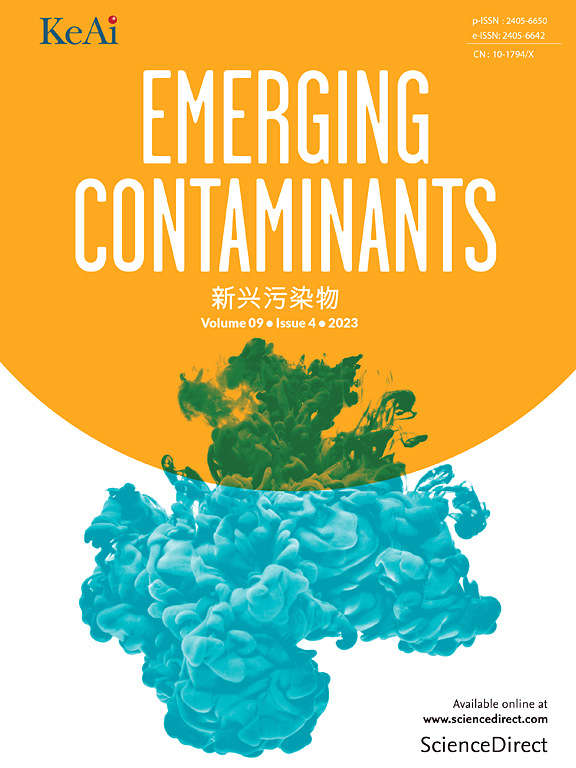Investigation and risk assessment of PCDDs, PCDFs, and dl-PCBs in Chinese mitten crab (Eriocheir sinensis) from the South Dongting lake area, China
IF 6.9
2区 环境科学与生态学
Q1 ENVIRONMENTAL SCIENCES
引用次数: 0
Abstract
Dioxins are among the common persistent organic pollutants in crabs. To clarify the potential risk of dioxins pollution in Chinese mitten crab, eight types of samples were collected in the South Dongting Lake area for the analysis of 17 PCDD/Fs and 12 dl-PCBs. The results indicate that the concentration of Σ PCDD/Fs and Σ dl-PCBs in crabs was between 0.993–10.8 and 35.0–282 pg/g w.w., respectively. The mean WHO-TEQ value of Σ PCDD/Fs in crabs was 0.248 ± 0.205 pg TEQ/g w.w., and the mean WHO-TEQ value of Σ PCDD/Fs + dl-PCBs in crabs was 0.359 ± 0.280 pg TEQ/g w.w. The total toxic equivalent of bottom sediment, surrounding soil, crab brown meat and juvenile crab were relatively high, which were 2.88, 2.67, 1.50 and 1.30 pg TEQ/g w.w., respectively. In the case of 99th percentile, the WHO-TEQ values of Σ PCDD/Fs and Σ PCDD/Fs + dl-PCBs in crab white meat were all within the maximum permitted levels as specified in commission regulation (EU) 2023/915. The HQ values of 99th percentile of Σ PCDD/Fs + dl-PCBs were 0.0783, 0.00703 and 0.0853 for eating brown meat products, eating white meat products and eating whole crabs, respectively. The coordinate points of the samples are connected to the origin by a straight line in the correspondence analysis map. The angle formed by the straight lines of crab brown meat/crab white meat and juvenile crab was acute angle, as did the feed. The angles between the straight line of bottom sediment/surrounding soil and that of other samples were all obtuse angles. In conclusion, although the dioxins of bottom sediment and surrounding soil are obvious, the dioxins of adult crabs are mainly related to that of the juvenile crabs and feed. At present, the intake of dioxins from Chinese mitten crab by Chinese residents is at a safe level because of low annual consumption. It is recommended that adults limit their weekly crab consumption to 1–4 crabs, or only 23.1–105 g of crab brown meat per week, or solely 435–1242 g of crab white meat per week.

南洞庭湖区中华绒螯蟹中pcdd、pcdf和dl-PCBs的调查与风险评价
二恶英是螃蟹体内常见的持久性有机污染物之一。为明确中华绒螯蟹二恶英污染的潜在风险,在南洞庭湖区采集了8种样品,对17种PCDD/Fs和12种dl-PCBs进行了分析。结果表明:鲎体内Σ PCDD/Fs和Σ dl-PCBs浓度分别为0.993 ~ 10.8和35.0 ~ 282 pg/g w.w.;蟹类中Σ PCDD/Fs的WHO-TEQ平均值为0.248±0.205 pg TEQ/g w.w, Σ PCDD/Fs + dl-PCBs的WHO-TEQ平均值为0.359±0.280 pg TEQ/g w.w,底泥、周围土壤、蟹棕肉和蟹幼肉的总毒性当量较高,分别为2.88、2.67、1.50和1.30 pg TEQ/g w.w。螃蟹白肉中Σ PCDD/Fs和Σ PCDD/Fs + dl-PCBs的WHO-TEQ值均在欧盟法规(EU) 2023/915规定的最大允许水平内。食用红肉制品、食用白肉制品和食用整蟹的Σ PCDD/Fs + dl-PCBs的第99百分位HQ值分别为0.0783、0.00703和0.0853。在对应分析图中,样品的坐标点通过一条直线与原点相连。蟹棕肉/蟹白肉与幼蟹直线形成的夹角为锐角,饵料也为锐角。底部沉积物/周围土壤的直线与其他样品的直线夹角均为钝角。综上所述,虽然底部沉积物和周围土壤的二恶英含量明显,但成体蟹的二恶英主要与幼蟹和饲料有关。目前我国居民从中华绒螯蟹中摄入的二恶英由于年消费量较低,处于安全水平。建议成年人每周只吃1-4只螃蟹,或者每周只吃23.1-105克蟹黄肉,或者每周只吃435-1242克蟹白肉。
本文章由计算机程序翻译,如有差异,请以英文原文为准。
求助全文
约1分钟内获得全文
求助全文
来源期刊

Emerging Contaminants
Medicine-Public Health, Environmental and Occupational Health
CiteScore
10.00
自引率
6.70%
发文量
35
审稿时长
44 days
期刊介绍:
Emerging Contaminants is an outlet for world-leading research addressing problems associated with environmental contamination caused by emerging contaminants and their solutions. Emerging contaminants are defined as chemicals that are not currently (or have been only recently) regulated and about which there exist concerns regarding their impact on human or ecological health. Examples of emerging contaminants include disinfection by-products, pharmaceutical and personal care products, persistent organic chemicals, and mercury etc. as well as their degradation products. We encourage papers addressing science that facilitates greater understanding of the nature, extent, and impacts of the presence of emerging contaminants in the environment; technology that exploits original principles to reduce and control their environmental presence; as well as the development, implementation and efficacy of national and international policies to protect human health and the environment from emerging contaminants.
 求助内容:
求助内容: 应助结果提醒方式:
应助结果提醒方式:


